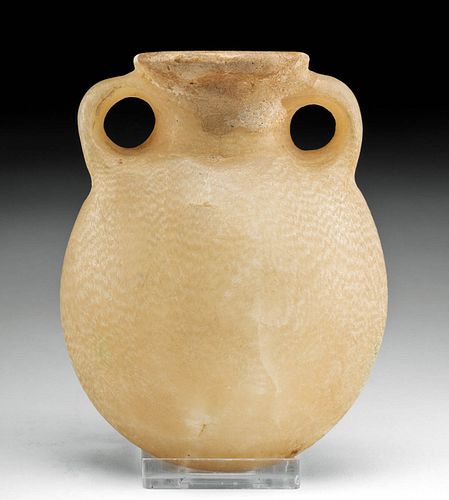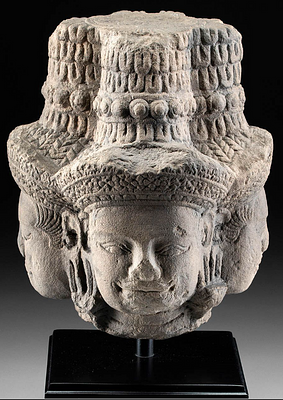Exhibited Egyptian New Kingdom Alabaster Pilgrim Flask
Lot 13
About Seller
Artemis Fine Arts
686 S Taylor Ave, Ste 106
Louisville, CO 80027
United States
Selling antiquities, ancient and ethnographic art online since 1993, Artemis Gallery specializes in Classical Antiquities (Egyptian, Greek, Roman, Near Eastern), Asian, Pre-Columbian, African / Tribal / Oceanographic art. Our extensive inventory includes pottery, stone, metal, wood, glass and textil...Read more
Categories
Estimate:
$5,000 - $7,500
Absentee vs Live bid
Two ways to bid:
- Leave a max absentee bid and the platform will bid on your behalf up to your maximum bid during the live auction.
- Bid live during the auction and your bids will be submitted real-time to the auctioneer.
Bid Increments
| Price | Bid Increment |
|---|---|
| $0 | $25 |
| $300 | $50 |
| $1,000 | $100 |
| $2,000 | $250 |
| $5,000 | $500 |
| $10,000 | $1,000 |
| $20,000 | $2,500 |
| $50,000 | $5,000 |
| $100,000 | $10,000 |
| $200,000 | $20,000 |
About Auction
By Artemis Fine Arts
Jun 29, 2023
Set Reminder
2023-06-29 10:00:00
2023-06-29 10:00:00
America/New_York
Bidsquare
Bidsquare : Exceptional Antiquities, Ethnographic and Fine Art
https://www.bidsquare.com/auctions/artemis-gallery/exceptional-antiquities-ethnographic-and-fine-art-13031
Artemis Fine Arts info@artemisfinearts.com
Artemis Fine Arts info@artemisfinearts.com
- Lot Description
Ancient Egypt, New Kingdom, 18th to 20th Dynasty, ca. 1550 to 1070 BCE. An exquisite alabaster pilgrim flask exhibiting honey yellow, wheat, sand, and tan. The vessel presents with lenticular walls and a carinated vertical spine, a pair of drilled handles on the shoulder, and an everted rim atop the squat neck. The interior cavity was formed by a series of larger drill bits and copious amounts of abrasive sand to a point where the interior drill marks can hardly be felt to the touch. Most pilgrim flasks like this were made from less expensive materials like pottery, so an example in alabaster is of far greater rarity. Size: 3.2" W x 4.1" H (8.1 cm x 10.4 cm)
Alabaster, which is a form of gypsum or calcite, was quarried along the length of the Nile River, from Giza to just south of Luxor, and the Egyptians made its carved forms famous throughout the ancient world. A thousand years later, while less common than black-figure or red-figure techniques, the Greeks made vessels like this out of pottery and painted them with white clay paint to imitate this beautiful stone.
Pilgrim flasks like this example were offered as a gift around July 19th, when the Egyptian New Year's festival took place (known as Wep Renpet, or Wp Rnpt, literally "The Opening of the Year"). It is not currently known what contents they were made to hold - some have suggested cosmetics, but others believe they may also have been made to hold the waters of the flooded Nile.
Exhibited in the Robert and Frances Fullerton Museum of Art (RAFFMA), California State University, San Bernardino from 1998 to 2023, reference number EL01.119.1998.
Cf. A pottery example at The Metropolitan Museum of Art, accession number 29.7.1.
A similar example of a larger size hammered for GBP 15,000 ($18,746.62) at Christie's, London "Antiquities" auction (sale 10372, April 15, 2015, lot 48).
Provenance: Collection of Dr. W. Benson Harer, Los Angeles, California, USA; Exhibited in the Robert and Frances Fullerton Museum of Art (RAFFMA), California State University, San Bernardino from 1998 to 2023, reference number EL01.119.1998.
All items legal to buy/sell under U.S. Statute covering cultural patrimony Code 2600, CHAPTER 14, and are guaranteed to be as described or your money back.
A Certificate of Authenticity will accompany all winning bids.
We ship worldwide and handle all shipping in-house for your convenience.
#178991Restoration to areas of rim with resurfacing and overpainting along new material and break lines. A few stable hairline fissures across body, with light abrasions, otherwise in excellent condition. Great surface smoothness on body and handles. Small green stain on one side of body.Condition
- Shipping Info
-
All shipping is handled in-house for your convenience. Your invoice from Artemis Gallery will include shipping calculation instructions. If in doubt, please inquire BEFORE bidding for estimated shipping costs for individual items.
-
- Buyer's Premium



 EUR
EUR CAD
CAD AUD
AUD GBP
GBP MXN
MXN HKD
HKD CNY
CNY MYR
MYR SEK
SEK SGD
SGD CHF
CHF THB
THB











